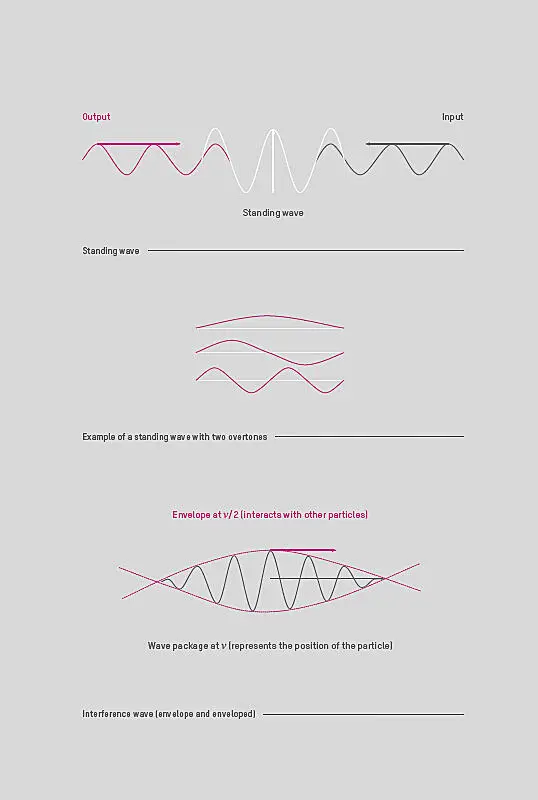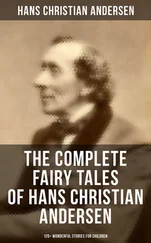The understanding of the elementary behaviour of waves opens the doors to all quantum phenomena. These have nothing to do with the idea of “atomos” (indivisible), but only the interference of radiation. The most obvious interferences encountered in everyday life are in musical instruments, for example the organ pipe: a sound wave seeks to escape from the pipe and is thrown back. As disorder in the pipe would need more energy than order, the incoming and outgoing waves oscillate synchronously, at the same wavelength and so that their nodes are at the same point. The result is a standing wave: the wave must fit in the pipe * —and this is the quantum effect!
A wave can be represented mathematically by a sine function. The calculation of the superposition of two such waves requires a simple trigonometrical relation2, which shows that two waves combine to form a single one, the product of a sine multiplied by a cosine. The sine is an envelope (not dependent on time): the abstract frame for the cosine, which actually oscillates within it in time.

If, unlike in an organ pipe, two interfering waves are differently formed, the interference wave does not remain standing. If the wave package in the envelope has velocity v , simple mathematics shows that the envelope only moves at v /2. 3
This fact alone can be used to derive fundamental laws of quantum mechanics:
–The de-Broglie-Einstein relations;4
–The rest frequency5 of a mass (Dirac 1928);
–Uncertainty.6
The following are also explained:
–The quantum of action7, the hydrogen atom8 and the harmonic oscillator9 are explained by the resonance of mechanical and quantum mechanical frequencies (similar to the resonance of a poorly-balanced wheel when its rotation frequency and the natural frequency of the wheel bearing are the same);
–Zero-point movement is explained from radiant energy being cancelled out by interference and transformed into kinetic energy;10
–The Schrödinger equation, from the superposition of the Lorentz contraction of relative velocity and potential field;11
–The Dirac equation from the rest frequency and the conservation of the energy and spin on each spatial axis;12
–Nuclear forces from the cancellation of field energy by the interference of particles at wavelength intervals.13
–Quantum entanglement (Einstein’s “ghostly remote effect”) arising from the fact that everything is connected via the continuum.14

Paul Dirac,
1902-1984
Quantum phenomena only seem puzzling if everyday expectations are projected onto the surface of atomic processes. It is in uncertainty that philosophy has been at its most adventurous—through to the concept of free will—and has intensified the uncertainty that emerges from the theory of relativity. The mysterious concept of the “dualism” of waves/particles is also unnecessary—a particle may interact as if it were a wave, but it always remains the particle that it is at rest, like a boat that causes a wave but remains a boat.
It is a given that quantum mechanics is an immeasurable creation; it is only through its existence that deductive physics becomes possible.15
The dynamics of elementary particles

Elementary particle
Elementary particles form the inner dynamics of that which appears outwardly to be an object with inertia and gravity, and possibly a charge. Inductive elementary particle physics cannot produce the connection between the internal and external. Deductive physics, however, does not seek to create a kind of bonsai proton, which already has its inertia, gravity, spin, charge, etc., but the dynamics that generate these phenomena. In the figure, the dynamics sought are represented by three points that emerge as vortices in the continuum and correspond to quarks in the standard model.
When continuum flows concentrically towards a point, the result is a black hole (if the Earth were condensed to a black hole, it would be the size of a cherry). Elementary particles, however, are not black holes: in the case of elementary particles, continuum does not flow radially, but tangentially, thus forming vortices. The frequency of rotation and the quantum mechanical frequency enter into resonance, which leads to an angular momentum ħ that determines the radius of a nucleon such as the proton.16 The ratio of the vortex radius of the proton to the radius it would have if it were a black hole is 10 38*: this means that, given an equal inflow volume, radically different configurations would form.
Structures
In a space filled with a continuum with properties c, G, ħ , elementary particles organise themselves:
–Vortices form, similar to a hurricane (which consists of air and rain, though it is not air and rain, but dynamics of these; vortices correspond to the building blocks of elementary particle physics, the quarks);
–The diameter of the vortex is determined by resonance;
–Vortices radiate that which flows to them (similarly to the “dynamics of masses”)—between radiations, interference and resonance occur, like in the organ pipe; in elementary particles its discrete tones correspond to specific frequencies and thus specific energies.
Individual vortices are not viable (no quarks have yet been isolated), but they attract one another by means of interferences (the cancelling out of field energy); in pairs they form the most short-lived mesons, and in threes they are perpendicular to one another (energy minimisation), forming baryons and leptons, including the stable proton, the stable electron and the relatively stable neutron.
Conserved quantities17

Three orthogonal vortices
Physics is founded on conserved quantities, such as those of energy, momentum, charge, which remain constant as a system evolves and can be relied upon. Elementary particle physics has introduced new conserved quantities: quantum numbers. From the start, elementary particle physics allocates to each particle a set of quantum numbers, which are retained at every particle decay and at every particle collision. As an analogy, a number of men (particles), some with hats, some with umbrellas or briefcases or both (quantum numbers), enter a meeting room, and after the meeting (collision of particles) go out again—but all the hats, umbrellas and briefcases are distributed differently among the men.
Deductive physics attributes these quantum numbers to the conservation of vortices and their structures. Since
–vortices are products of resonance and energy minimisation, they continue to exist in all processes. They form the foundations of all permanence of matter;
–vortices can only exist in structures made up of threes, the topology of the structures also remains intact, which means in particular that the vortices are being conserved on each of the three axes. (To this end the standard model has put forward the law that the quarks forming a particle must have three different “colours” which are being conserved;
Читать дальше
















